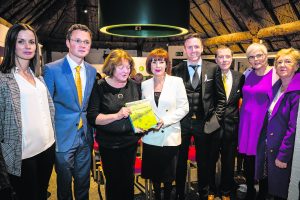
Representatives of Lough Gur Development Association called for substantial investment and support to unlock the unique potential of the historic area on the occasion of the official launch by Minister for Culture, Heritage and the Gaeltacht Josepha Madigan of a major new publication, ‘The Archaeology of Lough Gur’ last Thursday.
The Minister was in attendance to celebrate the publication of the book which was compiled by archaeologist, Rose Cleary.
Meeting the
needs of visitors
Lough Gur Development has expressed the view that a community group can no longer be expected to run a visitor attraction of global importance without significant investment and support to improve what was on offer, and meet the needs of local, national and international visitors. Those in attendance included ministers, councillors, Limerick City and County Council representatives, book sponsors Creative Ireland and Thomond Archaeological Society.
The importance of this book is emphasised by Dr Philip O’ Regan, Dean of the Kemmy Business School at the University of Limerick, who stated, “The Archaeology of Lough Gur highlights the importance of this area, not only in terms of the rich heritage that is found here but also for the untapped potential that exists in this area.”
Key tourism driver
“With the right level of support Lough Gur can become a key driver of tourism in the region. It is a site of international significance that has to date gone largely unrecognised. With over 1,000 field monuments within a 5km radius, and home to Ireland’s largest and oldest stone circle, this new publication clearly illustrates why we should all take more notice of this national treasure, ‘he added.
Minister Madigan, in an inspirational speech, stated, ”I look forward to enhancing the relationship with Lough Gur into the future and recognise the important role that local organisations play in preserving our heritage.”
Lifelong contribution
Minister Madigan referred to the lifelong work and significant contribution to Lough Gur by founding member of Lough Gur Development, Michael Quinlan, who sadly passed away this year and offered sincere condolences to the Quinlan family.
Michael’s daughter chairperson of Lough Gur Development, Áine Barry told those assembled, “the community development group have achieved a great deal including a €0.5m refurbishment of the visitor centre, growing visitor numbers from 2,000 to 45,000 and have now reached a critical point – if further support is not forthcoming the group will need to revaluate how they operate.”
“As a voluntary, not for profit organisation, Lough Gur Development cannot deliver the amenities and facilities required to further improve the area and improve economic growth for the surrounding areas.”
The next level
Kate Harrold, manager of Lough Gur Heritage Centre said, “the organisation has proven that they can expertly execute project and manage effectively. However, to move to the next level the group requires input from the government bodies responsible for Lough Gur, including the Office of Public Works, Department of the Environment and Limerick City and County Council. The community group are best placed to operate the facility and now need the support to do so.”
Occupied for
over 8,000 years
Author Rose Cleary explained that Lough Gur has been occupied continuously by people for over eight thousand years. The lake was, and is still, a focus within the community of Lough Gur and for the greater hinterland of Limerick as well as for visitors from Ireland, Britain, Europe and America. She added, “indeed, Lough Gur is unique in Western Europe in both the density and diversity of archaeological field monuments; it is truly an antique and storied land. It was a place where prehistoric Neolithic and Bronze Age settlements were discovered back in the 1940s when these types of sites were practically unknown elsewhere.”
“The surface remains of these are still visible above the ground which itself makes the Lough Gur landscape unique.”
Much of the information on Lough Gur has been published in various journals, including the local Lough Gur Historical Journal. This new publication now draws together the strands of information from various sources including antiquarian accounts to modern scientific excavation and provides a synthesis of the archaeological evidence as uncovered over the past 150 years.
A good friend
Rose Cleary has researched and excavated in Lough Gur for over 40 years and has become a good friend of Lough Gur Develop-ment. She was instrumental in overseeing the exhibition upgrade and approved content within the Heritage Centre when the facility was updated and refurbished in 2013.
Rose’s excavations in Lough Gur have enabled a review of older excavated material and to set it in the context of what is now known in Irish archaeology in terms of dating sites, reconstruction of past lives, including past beliefs, social structure, economies and contacts with other populations both within Ireland and abroad or how people lived here. These past societies shaped the landscape, and conversely the landscape shaped daily lives. Human activity is seen in the archaeological sites that reflect the ordinary activities of people whereby land was cultivated, houses were built, families reared and beliefs were expressed in things outside daily life. The impact of past societies is visible in the monuments at Lough Gur, such as the Great Stone Circle at Grange, the imposing tower house of Bourchier’s Castle, but also in less monumental sites such as the foundations of Stone Age houses on Knockadoon.
Primary guardians
Rose Cleary continued, “the care of the monuments around Lough Gur is the preserve of State agencies but the care also rests with those who live in areas where monuments remain. The preservation of sites reflects traditional respect for the fragments left behind by our ancestors. A reluctance to disturb or destroy old resting places helps to protect archaeological sites. In some respects, the monuments at Lough Gur have been saved by the absence of large scale ploughing and an appreciation of the unique landscape. There will always be a continuity of community in Lough Gur who are the primary the guardians of the archaeological heritage of the area. There must however be some benefit for the local community. There are two strands of thought on how monuments and archaeological landscapes are to be protected for the future. One would have a great barrier built around the area and an exclusion of all visitors and indeed this may preserve the sites but at what cost. No one would be allowed appreciate the archaeology set as it is in one of the most attractive landscapes in Ireland.”
Economic benefit
“The other school of thought is to present the monuments to the public in a controlled and organised fashion. This requires some planning and investment. The spin-off for the locality should be some economic benefit, whereby local people have an incentive to preserve and also present what is their heritage. This economic benefit could be the creation of some full or even part time jobs, the development of a field-school or the development of a trail though the landscape which will allow access but also retain and preserve the sites. The Lough Gur Development Company have been to the fore in trying to promote and develop the heritage in a sympathetic manner but the area needs a cash injection to expand the role of heritage within the community and the local economy.”
Rose thanked those who allowed her to excavate on their land, those who provided photographs for the book and ack-nowledged the efforts of everyone that had contributed to Lough Gur over the years.





